Digital Skills and Research Methods: Virtual Learning Impact Analysis
VerifiedAdded on 2022/12/30
|12
|2532
|24
Report
AI Summary
This report investigates the impact of virtual learning environments (VLEs) on students, particularly during the COVID-19 pandemic. It begins with an introduction, rationale, research objectives, and questions, followed by a literature review that examines the concept of VLEs, their benefits, and challenges. The methodology section outlines the research philosophy, approach, and data collection methods, including primary data collected through questionnaires and secondary data from internet sources. The primary data analysis presents findings on student perceptions of VLEs, including benefits like accessibility and time management. Secondary data analysis supports the literature review. The report concludes by summarizing the key findings and implications of VLEs on student learning during the pandemic, highlighting the need for ongoing evaluation and improvement of virtual learning strategies. The report includes references to support the research.
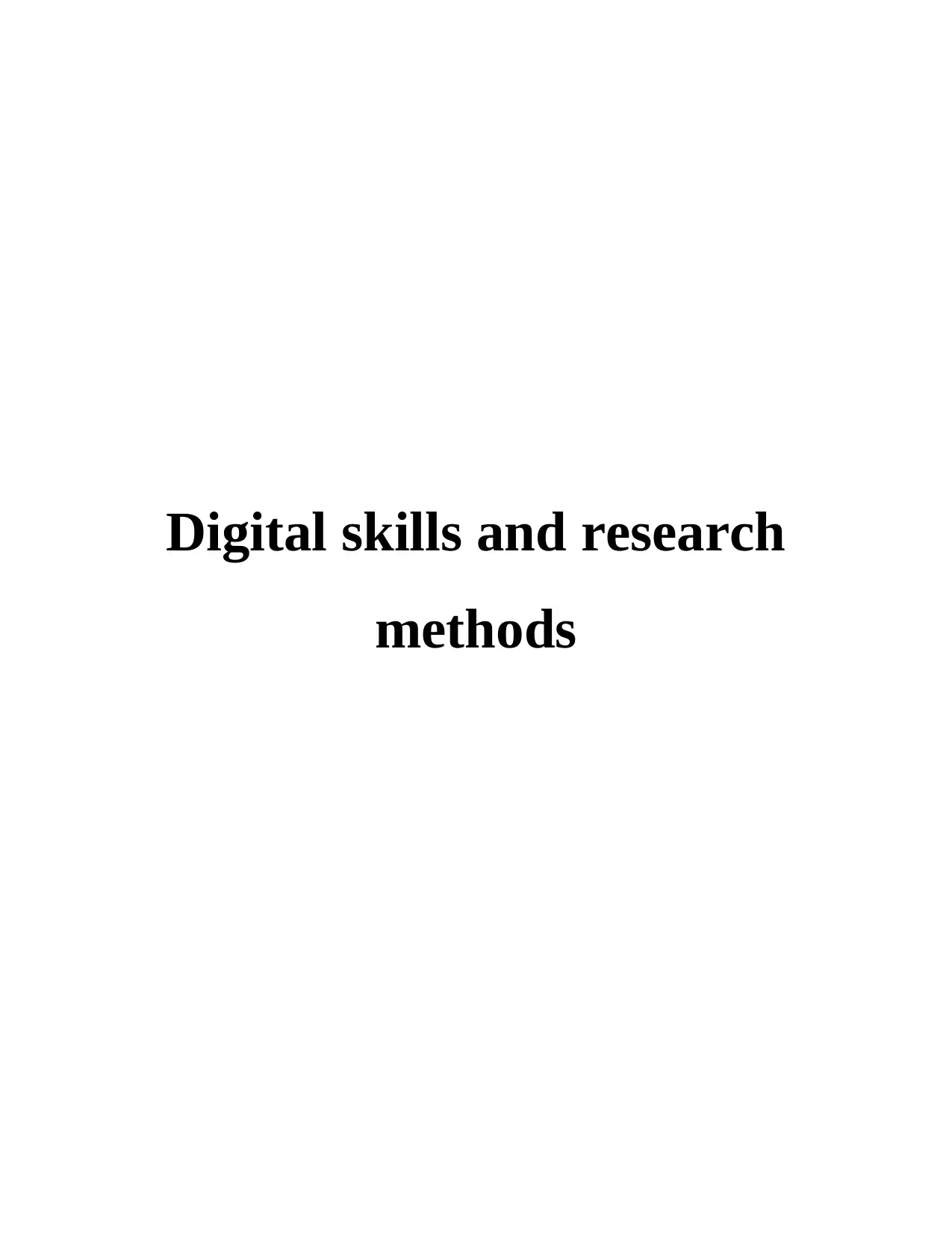
Digital skills and research
methods
methods
Paraphrase This Document
Need a fresh take? Get an instant paraphrase of this document with our AI Paraphraser
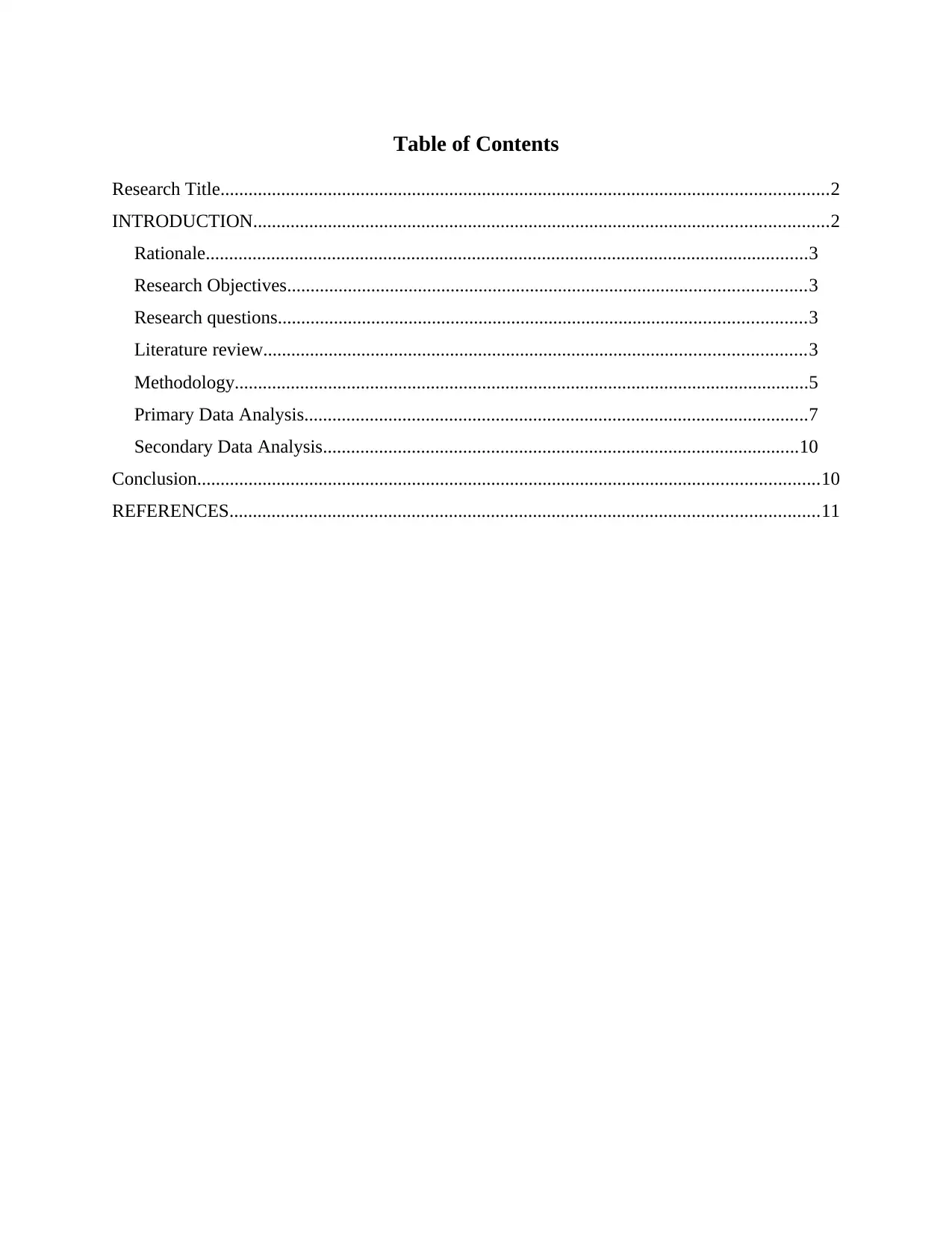
Table of Contents
Research Title..................................................................................................................................2
INTRODUCTION...........................................................................................................................2
Rationale.................................................................................................................................3
Research Objectives...............................................................................................................3
Research questions.................................................................................................................3
Literature review....................................................................................................................3
Methodology...........................................................................................................................5
Primary Data Analysis............................................................................................................7
Secondary Data Analysis......................................................................................................10
Conclusion.....................................................................................................................................10
REFERENCES..............................................................................................................................11
Research Title..................................................................................................................................2
INTRODUCTION...........................................................................................................................2
Rationale.................................................................................................................................3
Research Objectives...............................................................................................................3
Research questions.................................................................................................................3
Literature review....................................................................................................................3
Methodology...........................................................................................................................5
Primary Data Analysis............................................................................................................7
Secondary Data Analysis......................................................................................................10
Conclusion.....................................................................................................................................10
REFERENCES..............................................................................................................................11
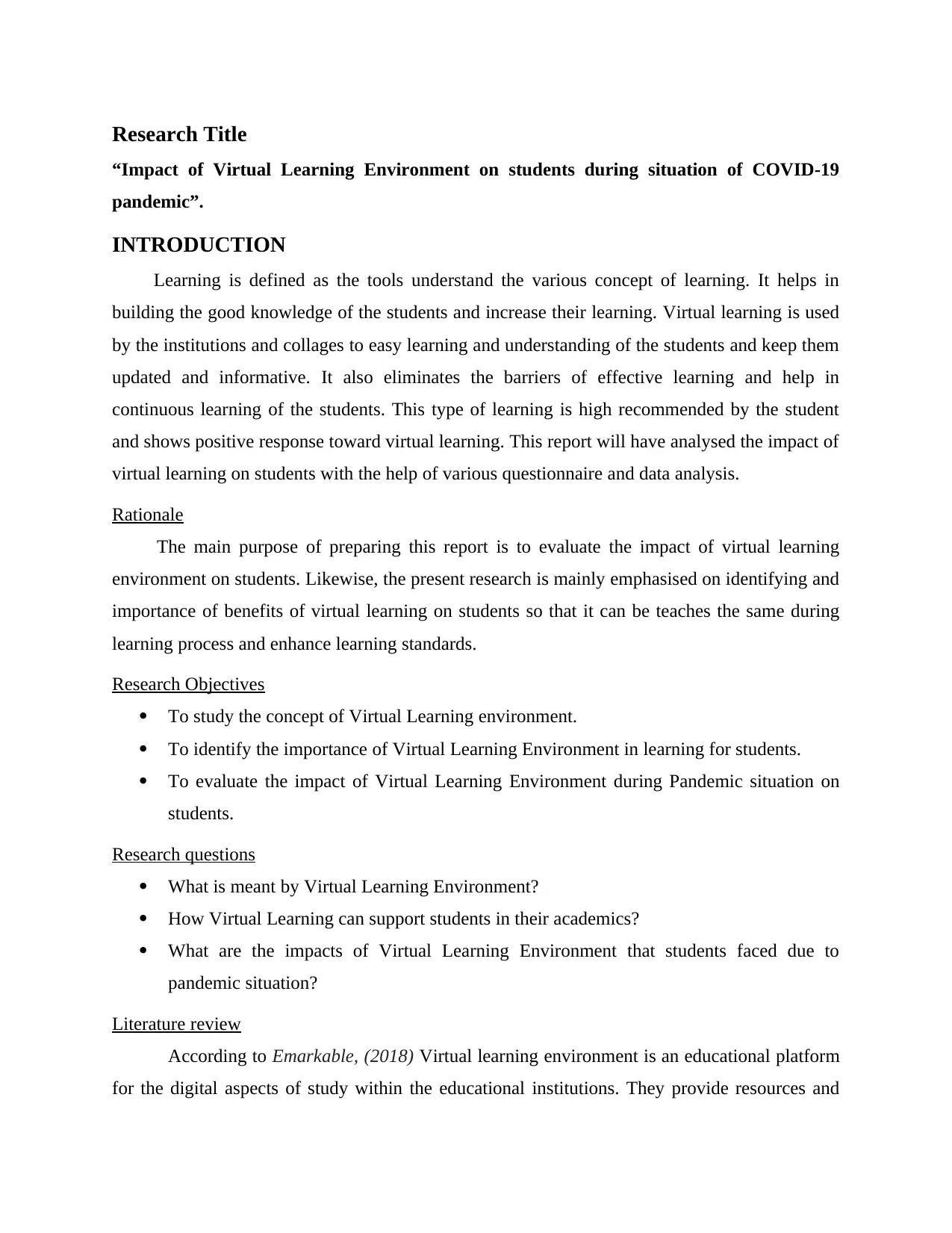
Research Title
“Impact of Virtual Learning Environment on students during situation of COVID-19
pandemic”.
INTRODUCTION
Learning is defined as the tools understand the various concept of learning. It helps in
building the good knowledge of the students and increase their learning. Virtual learning is used
by the institutions and collages to easy learning and understanding of the students and keep them
updated and informative. It also eliminates the barriers of effective learning and help in
continuous learning of the students. This type of learning is high recommended by the student
and shows positive response toward virtual learning. This report will have analysed the impact of
virtual learning on students with the help of various questionnaire and data analysis.
Rationale
The main purpose of preparing this report is to evaluate the impact of virtual learning
environment on students. Likewise, the present research is mainly emphasised on identifying and
importance of benefits of virtual learning on students so that it can be teaches the same during
learning process and enhance learning standards.
Research Objectives
To study the concept of Virtual Learning environment.
To identify the importance of Virtual Learning Environment in learning for students.
To evaluate the impact of Virtual Learning Environment during Pandemic situation on
students.
Research questions
What is meant by Virtual Learning Environment?
How Virtual Learning can support students in their academics?
What are the impacts of Virtual Learning Environment that students faced due to
pandemic situation?
Literature review
According to Emarkable, (2018) Virtual learning environment is an educational platform
for the digital aspects of study within the educational institutions. They provide resources and
“Impact of Virtual Learning Environment on students during situation of COVID-19
pandemic”.
INTRODUCTION
Learning is defined as the tools understand the various concept of learning. It helps in
building the good knowledge of the students and increase their learning. Virtual learning is used
by the institutions and collages to easy learning and understanding of the students and keep them
updated and informative. It also eliminates the barriers of effective learning and help in
continuous learning of the students. This type of learning is high recommended by the student
and shows positive response toward virtual learning. This report will have analysed the impact of
virtual learning on students with the help of various questionnaire and data analysis.
Rationale
The main purpose of preparing this report is to evaluate the impact of virtual learning
environment on students. Likewise, the present research is mainly emphasised on identifying and
importance of benefits of virtual learning on students so that it can be teaches the same during
learning process and enhance learning standards.
Research Objectives
To study the concept of Virtual Learning environment.
To identify the importance of Virtual Learning Environment in learning for students.
To evaluate the impact of Virtual Learning Environment during Pandemic situation on
students.
Research questions
What is meant by Virtual Learning Environment?
How Virtual Learning can support students in their academics?
What are the impacts of Virtual Learning Environment that students faced due to
pandemic situation?
Literature review
According to Emarkable, (2018) Virtual learning environment is an educational platform
for the digital aspects of study within the educational institutions. They provide resources and
⊘ This is a preview!⊘
Do you want full access?
Subscribe today to unlock all pages.

Trusted by 1+ million students worldwide
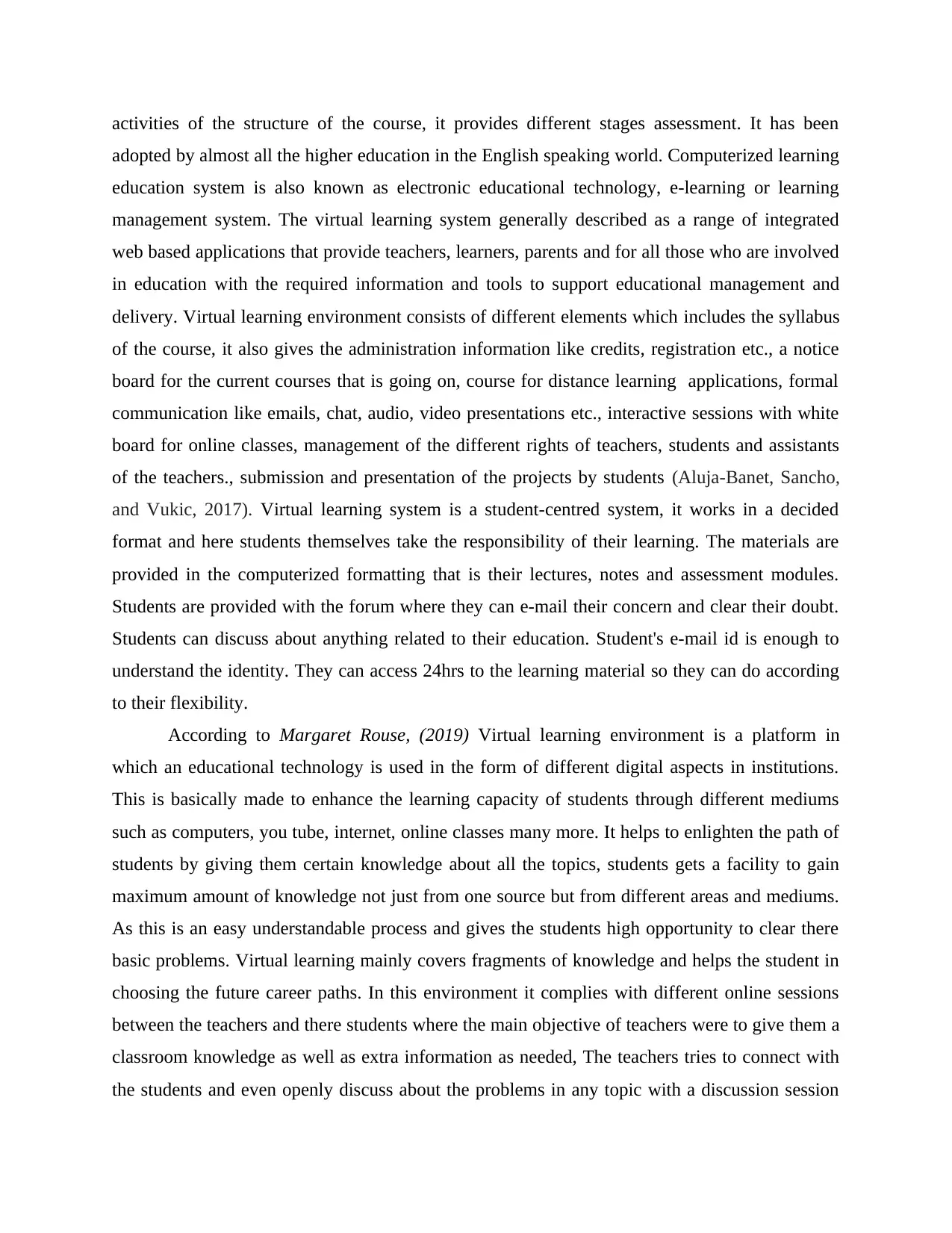
activities of the structure of the course, it provides different stages assessment. It has been
adopted by almost all the higher education in the English speaking world. Computerized learning
education system is also known as electronic educational technology, e-learning or learning
management system. The virtual learning system generally described as a range of integrated
web based applications that provide teachers, learners, parents and for all those who are involved
in education with the required information and tools to support educational management and
delivery. Virtual learning environment consists of different elements which includes the syllabus
of the course, it also gives the administration information like credits, registration etc., a notice
board for the current courses that is going on, course for distance learning applications, formal
communication like emails, chat, audio, video presentations etc., interactive sessions with white
board for online classes, management of the different rights of teachers, students and assistants
of the teachers., submission and presentation of the projects by students (Aluja-Banet, Sancho,
and Vukic, 2017). Virtual learning system is a student-centred system, it works in a decided
format and here students themselves take the responsibility of their learning. The materials are
provided in the computerized formatting that is their lectures, notes and assessment modules.
Students are provided with the forum where they can e-mail their concern and clear their doubt.
Students can discuss about anything related to their education. Student's e-mail id is enough to
understand the identity. They can access 24hrs to the learning material so they can do according
to their flexibility.
According to Margaret Rouse, (2019) Virtual learning environment is a platform in
which an educational technology is used in the form of different digital aspects in institutions.
This is basically made to enhance the learning capacity of students through different mediums
such as computers, you tube, internet, online classes many more. It helps to enlighten the path of
students by giving them certain knowledge about all the topics, students gets a facility to gain
maximum amount of knowledge not just from one source but from different areas and mediums.
As this is an easy understandable process and gives the students high opportunity to clear there
basic problems. Virtual learning mainly covers fragments of knowledge and helps the student in
choosing the future career paths. In this environment it complies with different online sessions
between the teachers and there students where the main objective of teachers were to give them a
classroom knowledge as well as extra information as needed, The teachers tries to connect with
the students and even openly discuss about the problems in any topic with a discussion session
adopted by almost all the higher education in the English speaking world. Computerized learning
education system is also known as electronic educational technology, e-learning or learning
management system. The virtual learning system generally described as a range of integrated
web based applications that provide teachers, learners, parents and for all those who are involved
in education with the required information and tools to support educational management and
delivery. Virtual learning environment consists of different elements which includes the syllabus
of the course, it also gives the administration information like credits, registration etc., a notice
board for the current courses that is going on, course for distance learning applications, formal
communication like emails, chat, audio, video presentations etc., interactive sessions with white
board for online classes, management of the different rights of teachers, students and assistants
of the teachers., submission and presentation of the projects by students (Aluja-Banet, Sancho,
and Vukic, 2017). Virtual learning system is a student-centred system, it works in a decided
format and here students themselves take the responsibility of their learning. The materials are
provided in the computerized formatting that is their lectures, notes and assessment modules.
Students are provided with the forum where they can e-mail their concern and clear their doubt.
Students can discuss about anything related to their education. Student's e-mail id is enough to
understand the identity. They can access 24hrs to the learning material so they can do according
to their flexibility.
According to Margaret Rouse, (2019) Virtual learning environment is a platform in
which an educational technology is used in the form of different digital aspects in institutions.
This is basically made to enhance the learning capacity of students through different mediums
such as computers, you tube, internet, online classes many more. It helps to enlighten the path of
students by giving them certain knowledge about all the topics, students gets a facility to gain
maximum amount of knowledge not just from one source but from different areas and mediums.
As this is an easy understandable process and gives the students high opportunity to clear there
basic problems. Virtual learning mainly covers fragments of knowledge and helps the student in
choosing the future career paths. In this environment it complies with different online sessions
between the teachers and there students where the main objective of teachers were to give them a
classroom knowledge as well as extra information as needed, The teachers tries to connect with
the students and even openly discuss about the problems in any topic with a discussion session
Paraphrase This Document
Need a fresh take? Get an instant paraphrase of this document with our AI Paraphraser
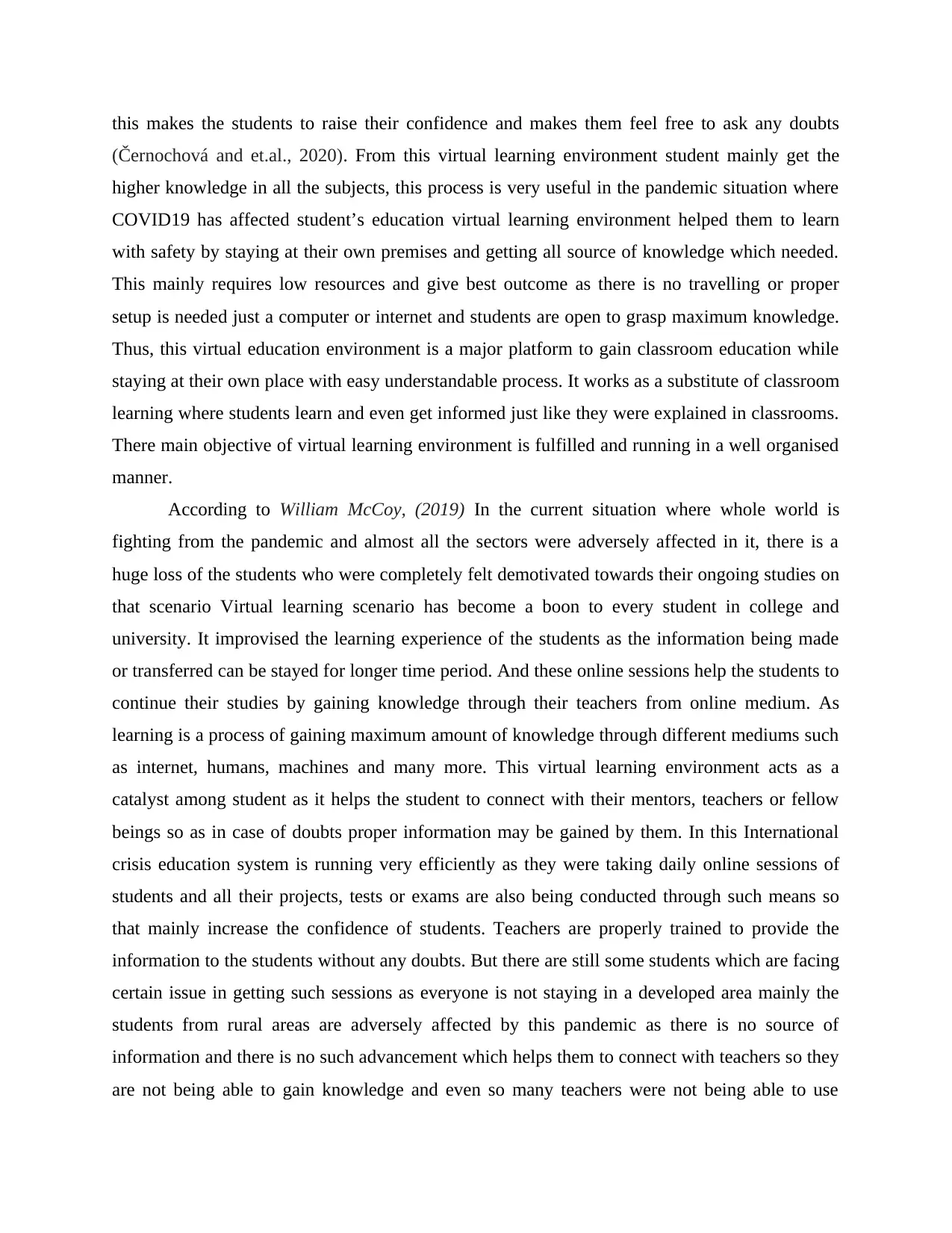
this makes the students to raise their confidence and makes them feel free to ask any doubts
(Černochová and et.al., 2020). From this virtual learning environment student mainly get the
higher knowledge in all the subjects, this process is very useful in the pandemic situation where
COVID19 has affected student’s education virtual learning environment helped them to learn
with safety by staying at their own premises and getting all source of knowledge which needed.
This mainly requires low resources and give best outcome as there is no travelling or proper
setup is needed just a computer or internet and students are open to grasp maximum knowledge.
Thus, this virtual education environment is a major platform to gain classroom education while
staying at their own place with easy understandable process. It works as a substitute of classroom
learning where students learn and even get informed just like they were explained in classrooms.
There main objective of virtual learning environment is fulfilled and running in a well organised
manner.
According to William McCoy, (2019) In the current situation where whole world is
fighting from the pandemic and almost all the sectors were adversely affected in it, there is a
huge loss of the students who were completely felt demotivated towards their ongoing studies on
that scenario Virtual learning scenario has become a boon to every student in college and
university. It improvised the learning experience of the students as the information being made
or transferred can be stayed for longer time period. And these online sessions help the students to
continue their studies by gaining knowledge through their teachers from online medium. As
learning is a process of gaining maximum amount of knowledge through different mediums such
as internet, humans, machines and many more. This virtual learning environment acts as a
catalyst among student as it helps the student to connect with their mentors, teachers or fellow
beings so as in case of doubts proper information may be gained by them. In this International
crisis education system is running very efficiently as they were taking daily online sessions of
students and all their projects, tests or exams are also being conducted through such means so
that mainly increase the confidence of students. Teachers are properly trained to provide the
information to the students without any doubts. But there are still some students which are facing
certain issue in getting such sessions as everyone is not staying in a developed area mainly the
students from rural areas are adversely affected by this pandemic as there is no source of
information and there is no such advancement which helps them to connect with teachers so they
are not being able to gain knowledge and even so many teachers were not being able to use
(Černochová and et.al., 2020). From this virtual learning environment student mainly get the
higher knowledge in all the subjects, this process is very useful in the pandemic situation where
COVID19 has affected student’s education virtual learning environment helped them to learn
with safety by staying at their own premises and getting all source of knowledge which needed.
This mainly requires low resources and give best outcome as there is no travelling or proper
setup is needed just a computer or internet and students are open to grasp maximum knowledge.
Thus, this virtual education environment is a major platform to gain classroom education while
staying at their own place with easy understandable process. It works as a substitute of classroom
learning where students learn and even get informed just like they were explained in classrooms.
There main objective of virtual learning environment is fulfilled and running in a well organised
manner.
According to William McCoy, (2019) In the current situation where whole world is
fighting from the pandemic and almost all the sectors were adversely affected in it, there is a
huge loss of the students who were completely felt demotivated towards their ongoing studies on
that scenario Virtual learning scenario has become a boon to every student in college and
university. It improvised the learning experience of the students as the information being made
or transferred can be stayed for longer time period. And these online sessions help the students to
continue their studies by gaining knowledge through their teachers from online medium. As
learning is a process of gaining maximum amount of knowledge through different mediums such
as internet, humans, machines and many more. This virtual learning environment acts as a
catalyst among student as it helps the student to connect with their mentors, teachers or fellow
beings so as in case of doubts proper information may be gained by them. In this International
crisis education system is running very efficiently as they were taking daily online sessions of
students and all their projects, tests or exams are also being conducted through such means so
that mainly increase the confidence of students. Teachers are properly trained to provide the
information to the students without any doubts. But there are still some students which are facing
certain issue in getting such sessions as everyone is not staying in a developed area mainly the
students from rural areas are adversely affected by this pandemic as there is no source of
information and there is no such advancement which helps them to connect with teachers so they
are not being able to gain knowledge and even so many teachers were not being able to use
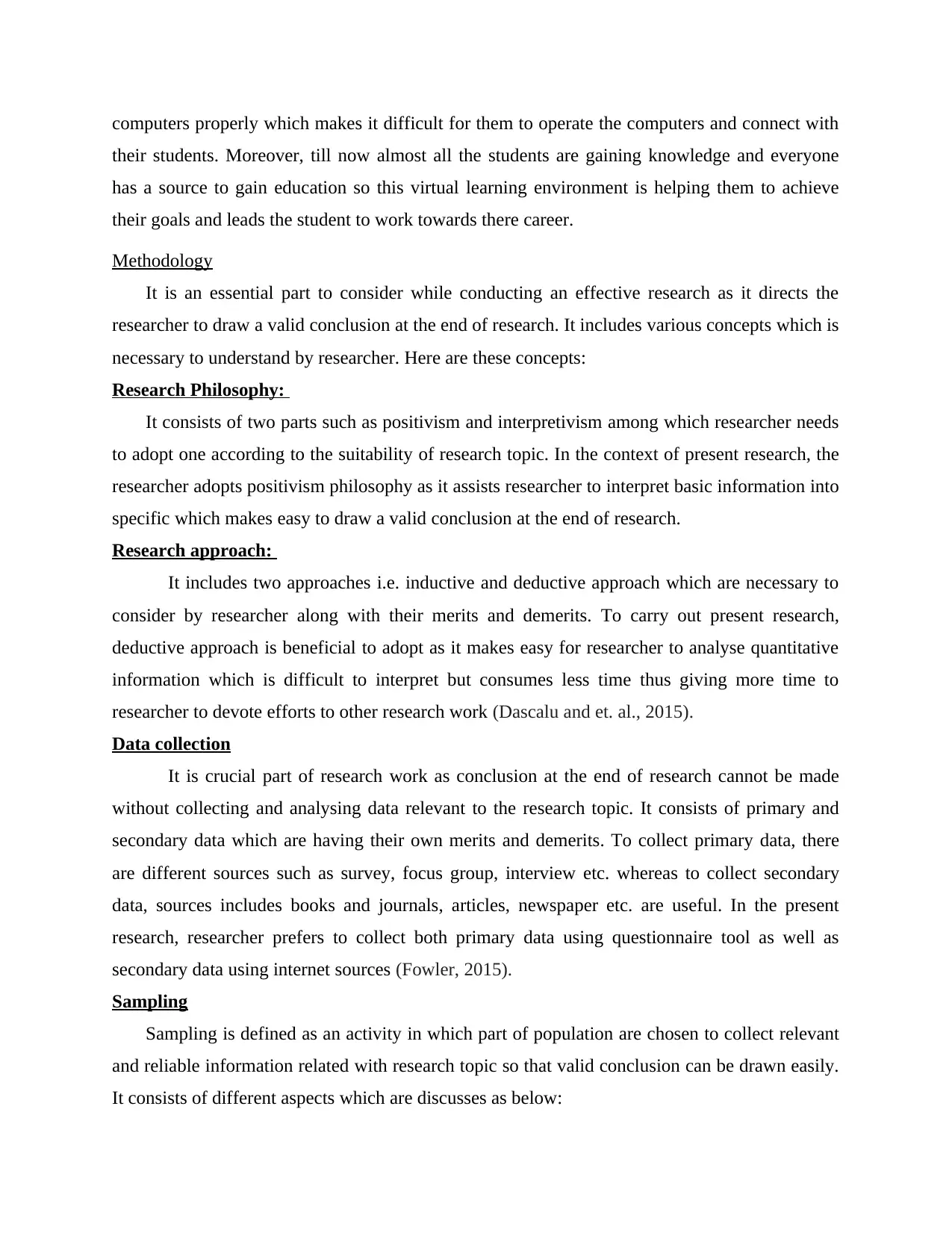
computers properly which makes it difficult for them to operate the computers and connect with
their students. Moreover, till now almost all the students are gaining knowledge and everyone
has a source to gain education so this virtual learning environment is helping them to achieve
their goals and leads the student to work towards there career.
Methodology
It is an essential part to consider while conducting an effective research as it directs the
researcher to draw a valid conclusion at the end of research. It includes various concepts which is
necessary to understand by researcher. Here are these concepts:
Research Philosophy:
It consists of two parts such as positivism and interpretivism among which researcher needs
to adopt one according to the suitability of research topic. In the context of present research, the
researcher adopts positivism philosophy as it assists researcher to interpret basic information into
specific which makes easy to draw a valid conclusion at the end of research.
Research approach:
It includes two approaches i.e. inductive and deductive approach which are necessary to
consider by researcher along with their merits and demerits. To carry out present research,
deductive approach is beneficial to adopt as it makes easy for researcher to analyse quantitative
information which is difficult to interpret but consumes less time thus giving more time to
researcher to devote efforts to other research work (Dascalu and et. al., 2015).
Data collection
It is crucial part of research work as conclusion at the end of research cannot be made
without collecting and analysing data relevant to the research topic. It consists of primary and
secondary data which are having their own merits and demerits. To collect primary data, there
are different sources such as survey, focus group, interview etc. whereas to collect secondary
data, sources includes books and journals, articles, newspaper etc. are useful. In the present
research, researcher prefers to collect both primary data using questionnaire tool as well as
secondary data using internet sources (Fowler, 2015).
Sampling
Sampling is defined as an activity in which part of population are chosen to collect relevant
and reliable information related with research topic so that valid conclusion can be drawn easily.
It consists of different aspects which are discusses as below:
their students. Moreover, till now almost all the students are gaining knowledge and everyone
has a source to gain education so this virtual learning environment is helping them to achieve
their goals and leads the student to work towards there career.
Methodology
It is an essential part to consider while conducting an effective research as it directs the
researcher to draw a valid conclusion at the end of research. It includes various concepts which is
necessary to understand by researcher. Here are these concepts:
Research Philosophy:
It consists of two parts such as positivism and interpretivism among which researcher needs
to adopt one according to the suitability of research topic. In the context of present research, the
researcher adopts positivism philosophy as it assists researcher to interpret basic information into
specific which makes easy to draw a valid conclusion at the end of research.
Research approach:
It includes two approaches i.e. inductive and deductive approach which are necessary to
consider by researcher along with their merits and demerits. To carry out present research,
deductive approach is beneficial to adopt as it makes easy for researcher to analyse quantitative
information which is difficult to interpret but consumes less time thus giving more time to
researcher to devote efforts to other research work (Dascalu and et. al., 2015).
Data collection
It is crucial part of research work as conclusion at the end of research cannot be made
without collecting and analysing data relevant to the research topic. It consists of primary and
secondary data which are having their own merits and demerits. To collect primary data, there
are different sources such as survey, focus group, interview etc. whereas to collect secondary
data, sources includes books and journals, articles, newspaper etc. are useful. In the present
research, researcher prefers to collect both primary data using questionnaire tool as well as
secondary data using internet sources (Fowler, 2015).
Sampling
Sampling is defined as an activity in which part of population are chosen to collect relevant
and reliable information related with research topic so that valid conclusion can be drawn easily.
It consists of different aspects which are discusses as below:
⊘ This is a preview!⊘
Do you want full access?
Subscribe today to unlock all pages.

Trusted by 1+ million students worldwide
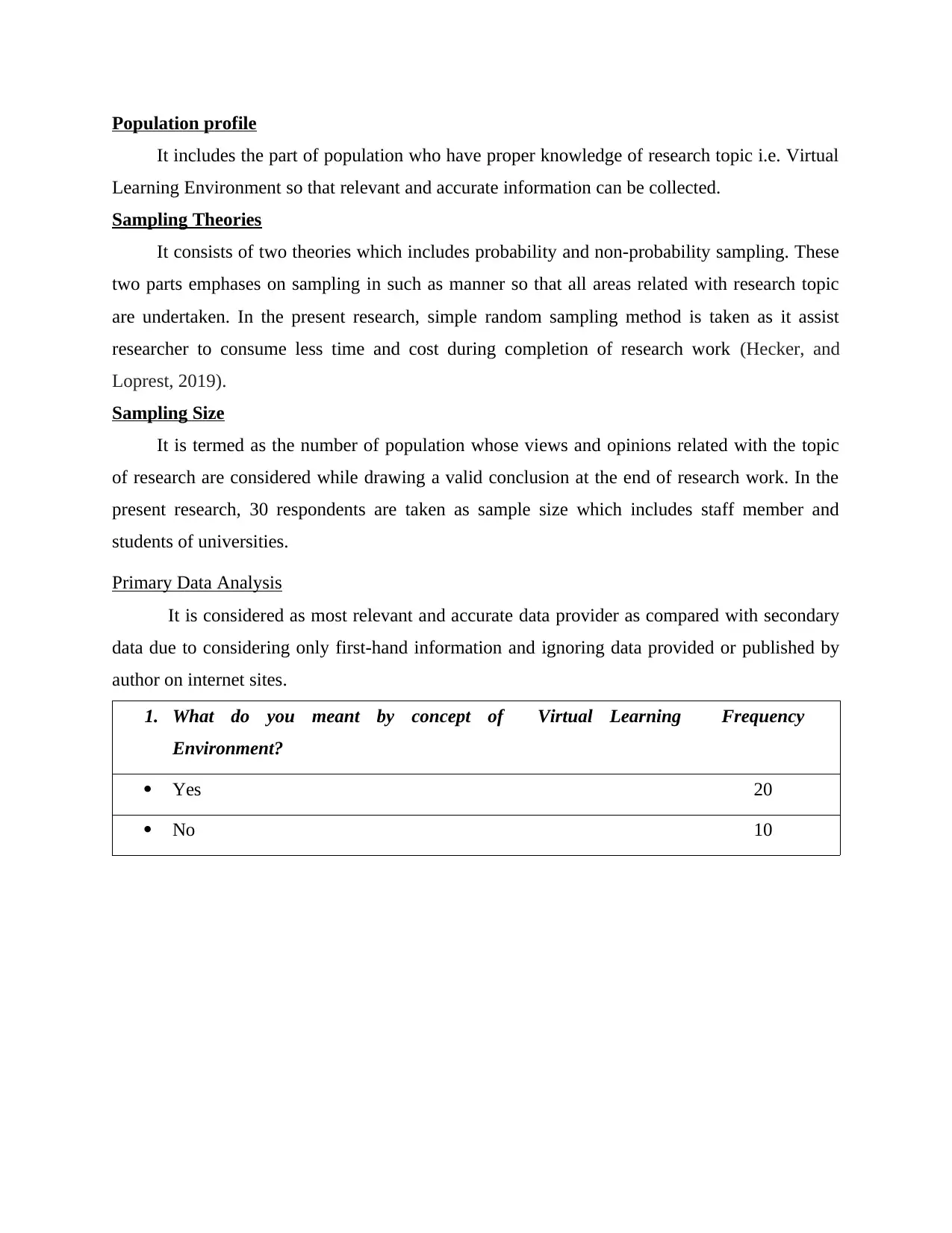
Population profile
It includes the part of population who have proper knowledge of research topic i.e. Virtual
Learning Environment so that relevant and accurate information can be collected.
Sampling Theories
It consists of two theories which includes probability and non-probability sampling. These
two parts emphases on sampling in such as manner so that all areas related with research topic
are undertaken. In the present research, simple random sampling method is taken as it assist
researcher to consume less time and cost during completion of research work (Hecker, and
Loprest, 2019).
Sampling Size
It is termed as the number of population whose views and opinions related with the topic
of research are considered while drawing a valid conclusion at the end of research work. In the
present research, 30 respondents are taken as sample size which includes staff member and
students of universities.
Primary Data Analysis
It is considered as most relevant and accurate data provider as compared with secondary
data due to considering only first-hand information and ignoring data provided or published by
author on internet sites.
1. What do you meant by concept of Virtual Learning
Environment?
Frequency
Yes 20
No 10
It includes the part of population who have proper knowledge of research topic i.e. Virtual
Learning Environment so that relevant and accurate information can be collected.
Sampling Theories
It consists of two theories which includes probability and non-probability sampling. These
two parts emphases on sampling in such as manner so that all areas related with research topic
are undertaken. In the present research, simple random sampling method is taken as it assist
researcher to consume less time and cost during completion of research work (Hecker, and
Loprest, 2019).
Sampling Size
It is termed as the number of population whose views and opinions related with the topic
of research are considered while drawing a valid conclusion at the end of research work. In the
present research, 30 respondents are taken as sample size which includes staff member and
students of universities.
Primary Data Analysis
It is considered as most relevant and accurate data provider as compared with secondary
data due to considering only first-hand information and ignoring data provided or published by
author on internet sites.
1. What do you meant by concept of Virtual Learning
Environment?
Frequency
Yes 20
No 10
Paraphrase This Document
Need a fresh take? Get an instant paraphrase of this document with our AI Paraphraser
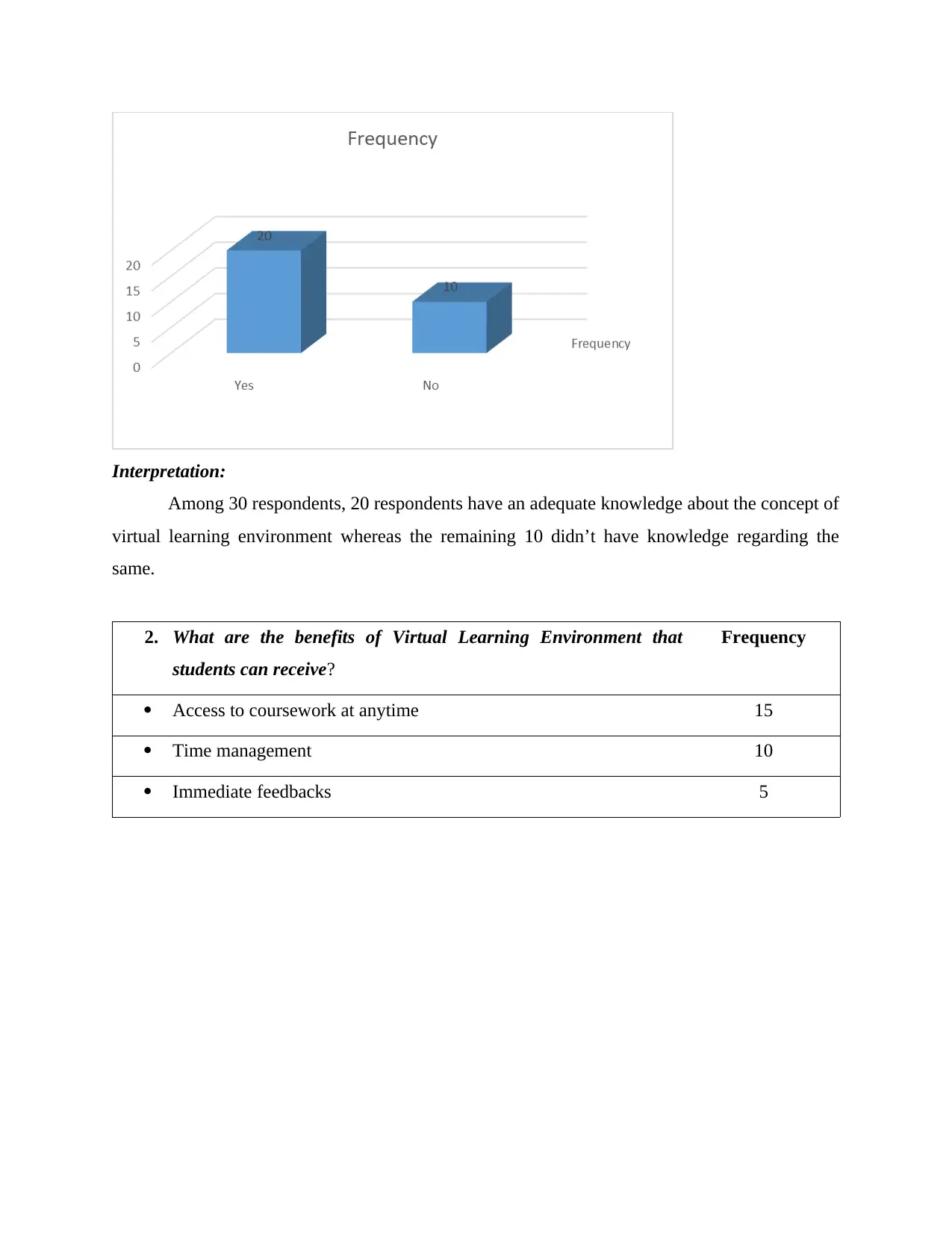
Interpretation:
Among 30 respondents, 20 respondents have an adequate knowledge about the concept of
virtual learning environment whereas the remaining 10 didn’t have knowledge regarding the
same.
2. What are the benefits of Virtual Learning Environment that
students can receive?
Frequency
Access to coursework at anytime 15
Time management 10
Immediate feedbacks 5
Among 30 respondents, 20 respondents have an adequate knowledge about the concept of
virtual learning environment whereas the remaining 10 didn’t have knowledge regarding the
same.
2. What are the benefits of Virtual Learning Environment that
students can receive?
Frequency
Access to coursework at anytime 15
Time management 10
Immediate feedbacks 5
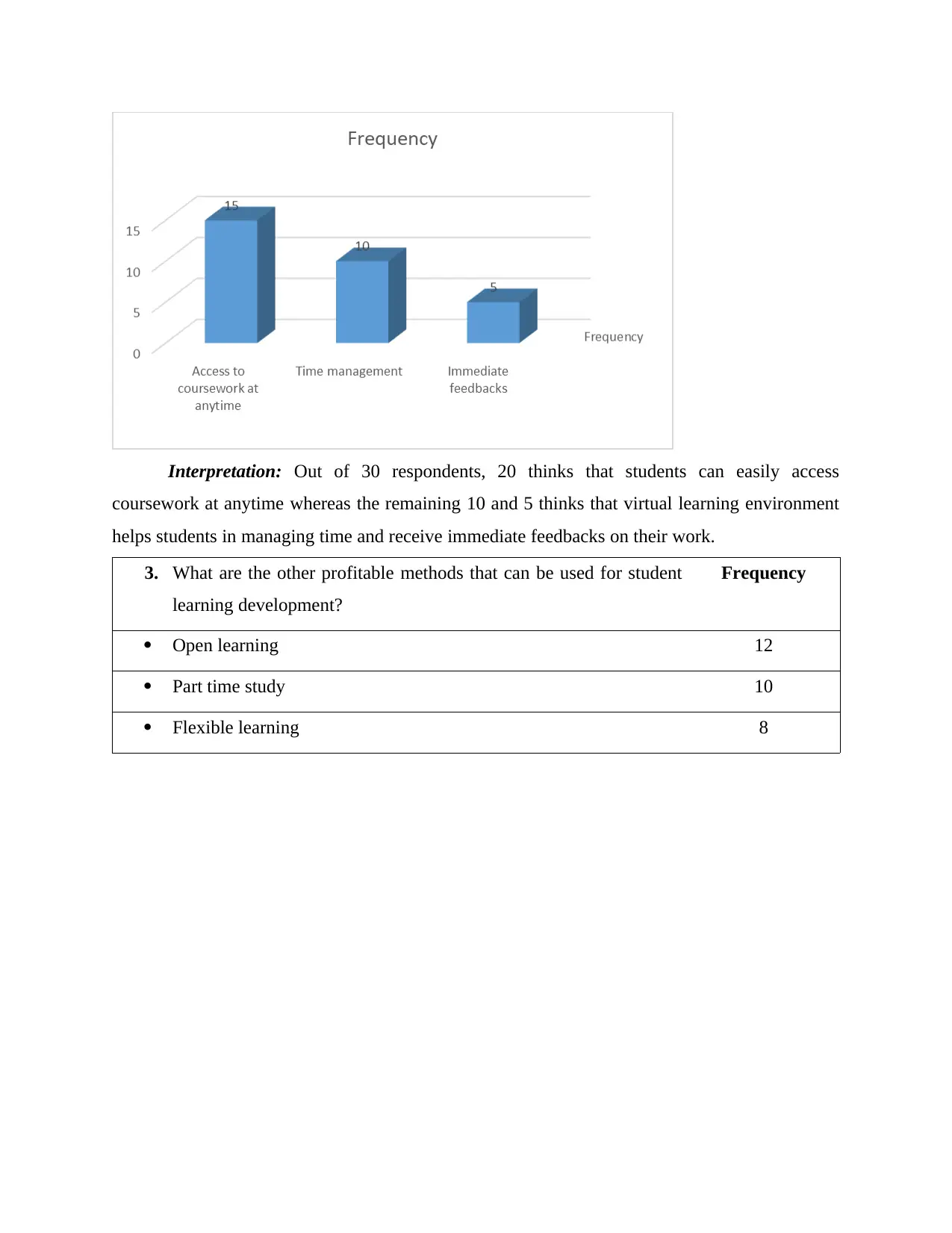
Interpretation: Out of 30 respondents, 20 thinks that students can easily access
coursework at anytime whereas the remaining 10 and 5 thinks that virtual learning environment
helps students in managing time and receive immediate feedbacks on their work.
3. What are the other profitable methods that can be used for student
learning development?
Frequency
Open learning 12
Part time study 10
Flexible learning 8
coursework at anytime whereas the remaining 10 and 5 thinks that virtual learning environment
helps students in managing time and receive immediate feedbacks on their work.
3. What are the other profitable methods that can be used for student
learning development?
Frequency
Open learning 12
Part time study 10
Flexible learning 8
⊘ This is a preview!⊘
Do you want full access?
Subscribe today to unlock all pages.

Trusted by 1+ million students worldwide
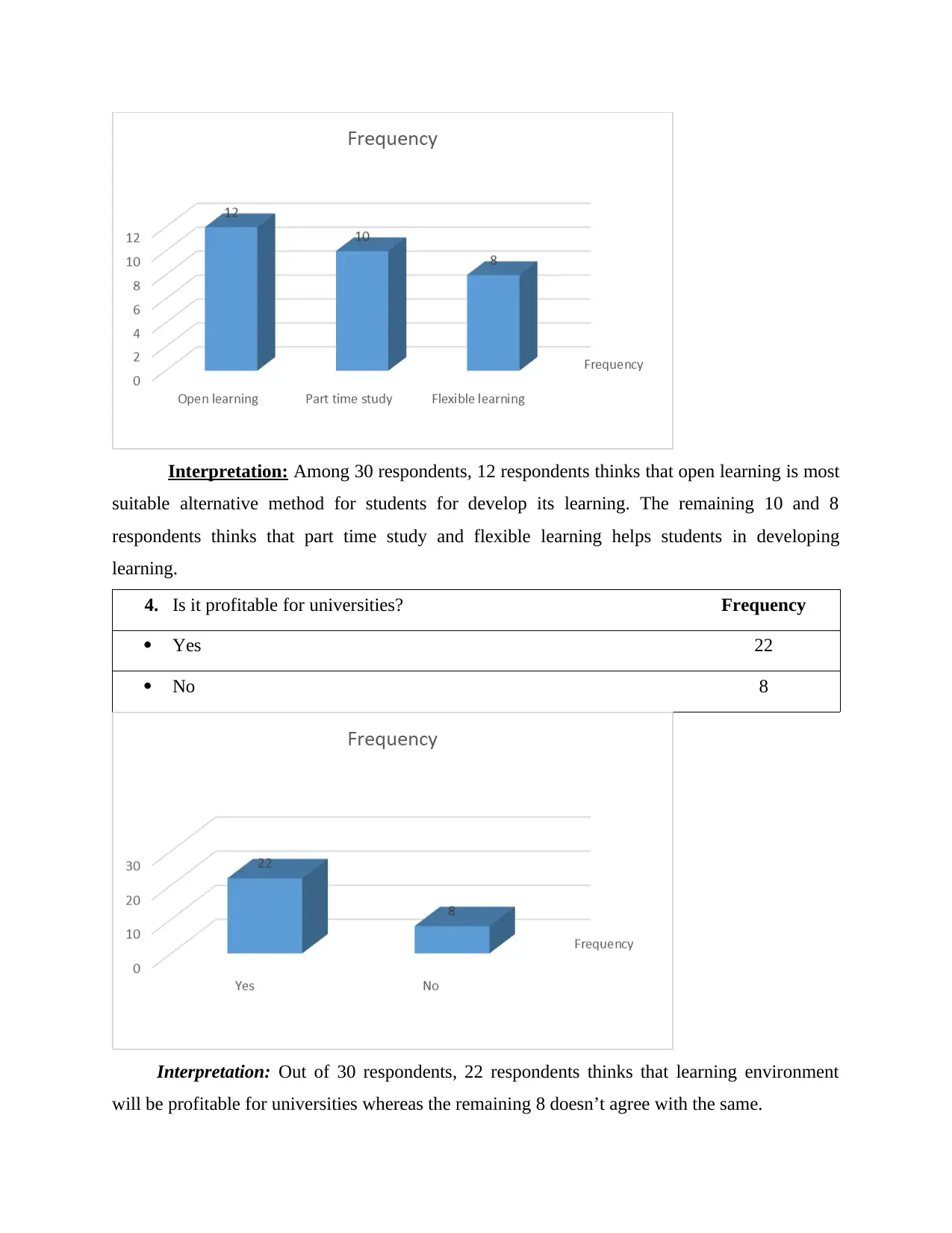
Interpretation: Among 30 respondents, 12 respondents thinks that open learning is most
suitable alternative method for students for develop its learning. The remaining 10 and 8
respondents thinks that part time study and flexible learning helps students in developing
learning.
4. Is it profitable for universities? Frequency
Yes 22
No 8
Interpretation: Out of 30 respondents, 22 respondents thinks that learning environment
will be profitable for universities whereas the remaining 8 doesn’t agree with the same.
suitable alternative method for students for develop its learning. The remaining 10 and 8
respondents thinks that part time study and flexible learning helps students in developing
learning.
4. Is it profitable for universities? Frequency
Yes 22
No 8
Interpretation: Out of 30 respondents, 22 respondents thinks that learning environment
will be profitable for universities whereas the remaining 8 doesn’t agree with the same.
Paraphrase This Document
Need a fresh take? Get an instant paraphrase of this document with our AI Paraphraser
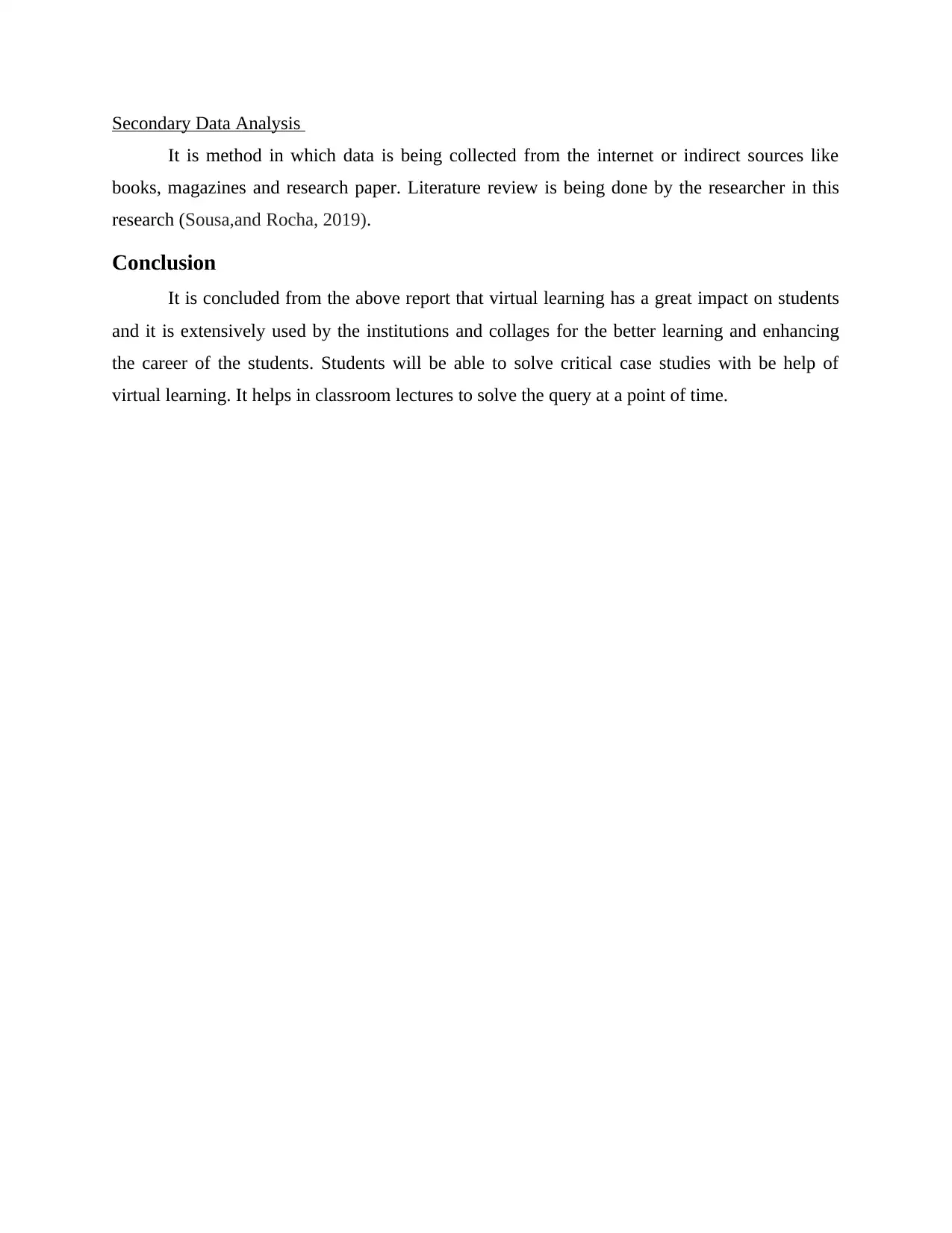
Secondary Data Analysis
It is method in which data is being collected from the internet or indirect sources like
books, magazines and research paper. Literature review is being done by the researcher in this
research (Sousa,and Rocha, 2019).
Conclusion
It is concluded from the above report that virtual learning has a great impact on students
and it is extensively used by the institutions and collages for the better learning and enhancing
the career of the students. Students will be able to solve critical case studies with be help of
virtual learning. It helps in classroom lectures to solve the query at a point of time.
It is method in which data is being collected from the internet or indirect sources like
books, magazines and research paper. Literature review is being done by the researcher in this
research (Sousa,and Rocha, 2019).
Conclusion
It is concluded from the above report that virtual learning has a great impact on students
and it is extensively used by the institutions and collages for the better learning and enhancing
the career of the students. Students will be able to solve critical case studies with be help of
virtual learning. It helps in classroom lectures to solve the query at a point of time.
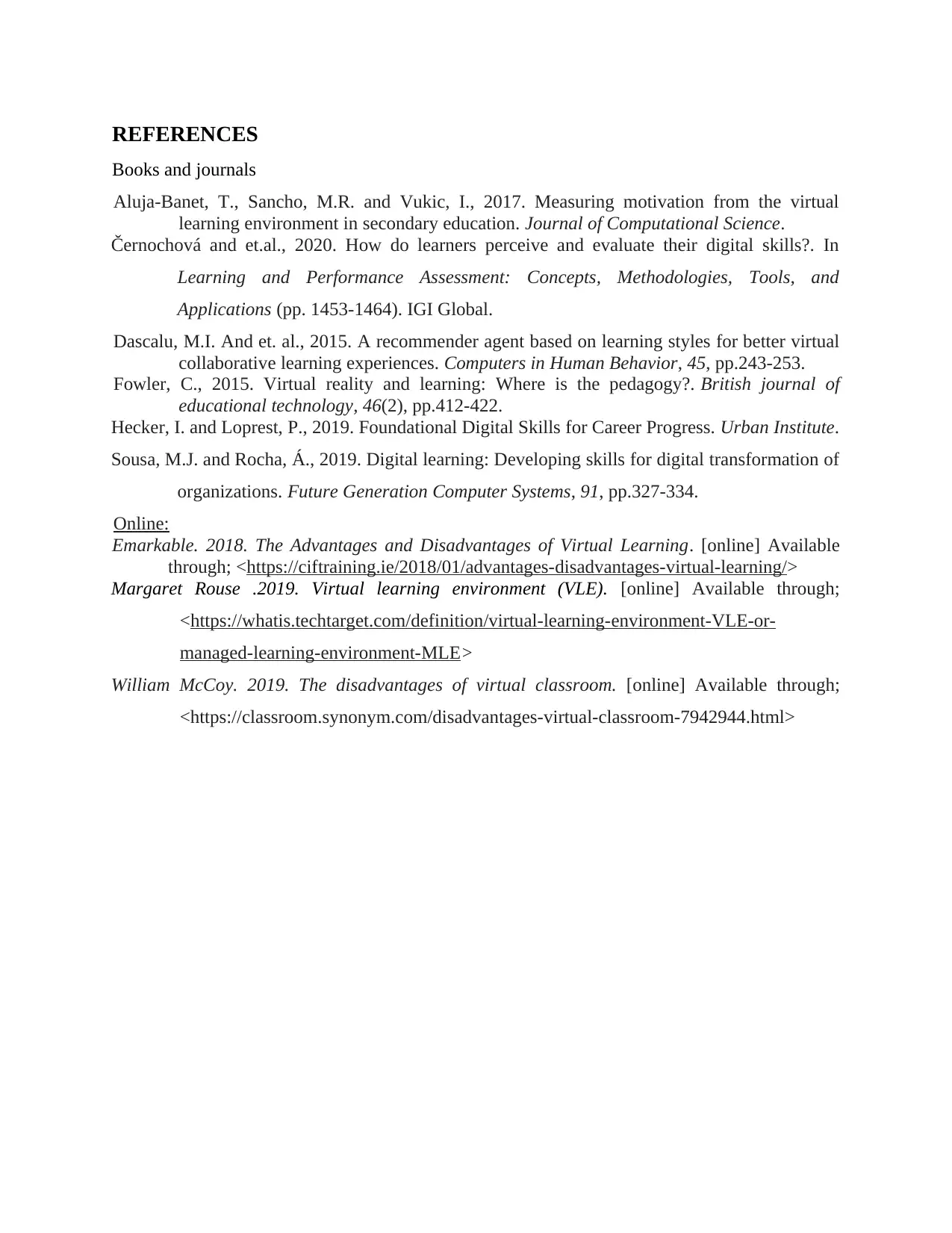
REFERENCES
Books and journals
Aluja-Banet, T., Sancho, M.R. and Vukic, I., 2017. Measuring motivation from the virtual
learning environment in secondary education. Journal of Computational Science.
Černochová and et.al., 2020. How do learners perceive and evaluate their digital skills?. In
Learning and Performance Assessment: Concepts, Methodologies, Tools, and
Applications (pp. 1453-1464). IGI Global.
Dascalu, M.I. And et. al., 2015. A recommender agent based on learning styles for better virtual
collaborative learning experiences. Computers in Human Behavior, 45, pp.243-253.
Fowler, C., 2015. Virtual reality and learning: Where is the pedagogy?. British journal of
educational technology, 46(2), pp.412-422.
Hecker, I. and Loprest, P., 2019. Foundational Digital Skills for Career Progress. Urban Institute.
Sousa, M.J. and Rocha, Á., 2019. Digital learning: Developing skills for digital transformation of
organizations. Future Generation Computer Systems, 91, pp.327-334.
Online:
Emarkable. 2018. The Advantages and Disadvantages of Virtual Learning. [online] Available
through; <https://ciftraining.ie/2018/01/advantages-disadvantages-virtual-learning/>
Margaret Rouse .2019. Virtual learning environment (VLE). [online] Available through;
<https://whatis.techtarget.com/definition/virtual-learning-environment-VLE-or-
managed-learning-environment-MLE>
William McCoy. 2019. The disadvantages of virtual classroom. [online] Available through;
<https://classroom.synonym.com/disadvantages-virtual-classroom-7942944.html>
Books and journals
Aluja-Banet, T., Sancho, M.R. and Vukic, I., 2017. Measuring motivation from the virtual
learning environment in secondary education. Journal of Computational Science.
Černochová and et.al., 2020. How do learners perceive and evaluate their digital skills?. In
Learning and Performance Assessment: Concepts, Methodologies, Tools, and
Applications (pp. 1453-1464). IGI Global.
Dascalu, M.I. And et. al., 2015. A recommender agent based on learning styles for better virtual
collaborative learning experiences. Computers in Human Behavior, 45, pp.243-253.
Fowler, C., 2015. Virtual reality and learning: Where is the pedagogy?. British journal of
educational technology, 46(2), pp.412-422.
Hecker, I. and Loprest, P., 2019. Foundational Digital Skills for Career Progress. Urban Institute.
Sousa, M.J. and Rocha, Á., 2019. Digital learning: Developing skills for digital transformation of
organizations. Future Generation Computer Systems, 91, pp.327-334.
Online:
Emarkable. 2018. The Advantages and Disadvantages of Virtual Learning. [online] Available
through; <https://ciftraining.ie/2018/01/advantages-disadvantages-virtual-learning/>
Margaret Rouse .2019. Virtual learning environment (VLE). [online] Available through;
<https://whatis.techtarget.com/definition/virtual-learning-environment-VLE-or-
managed-learning-environment-MLE>
William McCoy. 2019. The disadvantages of virtual classroom. [online] Available through;
<https://classroom.synonym.com/disadvantages-virtual-classroom-7942944.html>
⊘ This is a preview!⊘
Do you want full access?
Subscribe today to unlock all pages.

Trusted by 1+ million students worldwide
1 out of 12
Related Documents
Your All-in-One AI-Powered Toolkit for Academic Success.
+13062052269
info@desklib.com
Available 24*7 on WhatsApp / Email
![[object Object]](/_next/static/media/star-bottom.7253800d.svg)
Unlock your academic potential
Copyright © 2020–2025 A2Z Services. All Rights Reserved. Developed and managed by ZUCOL.





